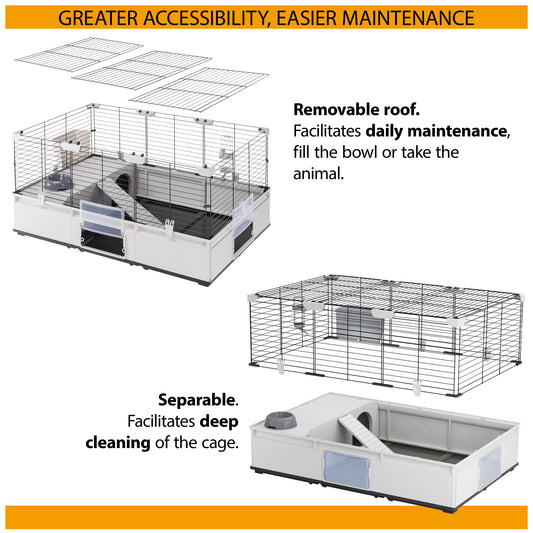Can dogs experience stress?
On the face of it, you’d think that the average pet dog was living the dream – stretched out in a comfy bed for most of the day, food brought to them at regular intervals, and no financial responsibilities. What could dogs possibly be stressed by?
Dogs can experience stress and anxiety in the same way as we do, and research carried out by the University of Helsinki in Finland in 2020 found that more than 70% of dogs displayed signs of anxiety. The most common of these anxiety traits was noise sensitivity, with 32% of dogs being highly fearful of at least one noise.
Prolonged periods of stress can be very damaging to a pet’s welfare so it is important that owners know how to recognise the signs that their pet is suffering and take steps to help them.
How do I know if my dog is stressed?
Dogs are skilled communicators and will clearly tell you when they are anxious – you just need to know how to understand them. Most of the signs will be given through their body language so if you notice any of the following behaviours in your pet, you can be sure that there is something they’re not happy about!
- Excessive yawning
- Panting
- Licking lips
- Shaking/trembling
- Ears held back
- Pacing/won’t settle
- Dilated pupils
- Tail tucked between legs
- Loss of appetite
- Cowering/shrinking away
- Low body posture
What can cause a dog stress?
Some dogs seem to be more prone to stress than others and this could be an indication of trauma or insufficient socialisation when they were a puppy. During the first 16 weeks of a dog’s life, they are open to new experiences and ready to explore the world around them. This is the time when they should be exposed to all the things they are likely to encounter during their adult life – traffic, walking on different surfaces, people with beards or who are wearing hats, children, the vet, vacuum cleaners, bin lorries, ambulance sirens, aeroplanes, babies crying, as well as getting used to being handled and groomed.
If a dog experiences something for the first time after this window of socialisation – especially during the adolescent period of 6 months to 1.5 years – they can become fearful of it, which can lead to issues later in life if they encounter it again.
Separation anxiety is also a common cause of stress for some dogs who have not been taught how to be happy on their own. As social creatures, dogs do not like being left for long periods and, if an owner does not get them used to time alone when they are young, it is likely to cause stress if they need to be left when they are older.
Dogs are creatures of habit so changes in routine can unsettle them, as well as boredom and frustration. Sometimes it is obvious what is triggering a dog’s anxiety – such as fireworks going off or a visit to the vet – but other times you might need to play detective to get to the bottom of your dog’s stress. If you notice that your pet is showing signs of stress and it is not obvious why, you should speak to your vet. It could be that a referral to a canine behaviourist is necessary.
Dogs are experts at observing our moods and can take in lots of information, such as our facial expressions, posture, and tone of voice, to predict how we will respond to a particular situation. If we are stressed or anxious, our dogs will know it and it is likely they will mimic our responses.
When an owner reacts calmly to an event, it is more likely that their dog will approach it in the same way. When an owner is anxious, a dog will pick up on the signs but won’t necessarily know what has caused it. As a result, they are likely to feel insecure and vulnerable.
How to keep calm and carry on
If you have an anxious dog, there are some things you can do to make life less stressful for them.
- Maintain a routine as much as possible. If you can keep meal times, exercise times and bed times consistent, anxious dogs are likely to be happier and more settled.
- Ensure your dog has a safe retreat that they can hide away in if they need some space. This is particularly useful for dogs with firework or thunderstorm phobias. Create a cosy, dark den and do not disturb your dog when they are in there.
- Keep your cool and make sure you always talk to your dog in a calm manner. Any shouting or erratic body language is likely to upset an anxious dog.
- Speak to your vet about using a canine pheromone plug-in diffuser. This is a synthetic version of a smell that nursing mothers give off to let their puppies know they are safe. Scientific studies have shown Dog-Appeasing Pheromones (DAP) are effective at treating separation anxiety and owners report success with relieving noise phobias and other causes of anxiety too. Alternatively, you can try an essential oil diffuser or spray, which use a blend of natural calming herbs such as valerian.
- Licking is a soothing activity for dogs and something that they instinctively do to calm themselves. Providing your dog with a food-stuffed Kong or lick mat is a great way to encourage licking while providing a distraction from whatever is causing them unhappiness.
Danger!
If you ignore the signs that your dog is experiencing stress, they are likely to result in more drastic measures to get your attention or try dealing with the situation themselves. Dogs will only react in an aggressive way as a last resort, but if it happens it can be very dangerous. If your dog starts displaying signs of aggression – such as growling or biting – seek veterinary advice immediately.
Shop All Dog
If you enjoyed this article, you may find these interesting:
Keep Your Dog Calm and Carry On!
Why has my dog stopped eating?









